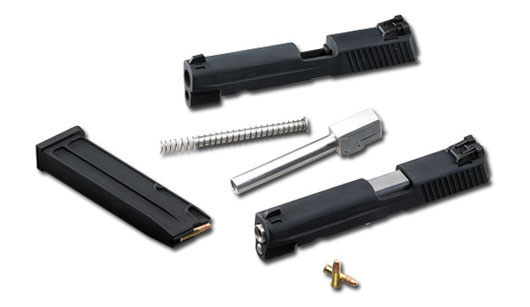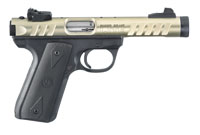
Sub-caliber training allows law enforcement personnel to shoot multiple training drills with thousands of rounds for the cost of one to two boxes of .40-caliber ammunition.
After a recent LE training event, I came away with an entirely new outlook on sub-caliber training. Given today’s ever-shrinking budgets, this is an option every department needs to give serious consideration — not to mention the advantages of increased personal trigger time.
On the range, we went through a host of different drills that were tailored to sub-caliber conversions. Where necessary, the targets were smaller and distances shorter, but the excitement and benefits were undeniable. The arguments for sub-caliber training are really rather simple — increased trigger time and reduced expense.
Let’s take the AR platform as an example. A .22LR bullet is .222 and a .223 (5.56) is closer to .224. The difference is negligible for training purposes and group size/impact points are comparable out to at least 25 yards. Of course, the beauty of the AR is its modular nature.
For training, you have three options. First, there are several drop-in conversion kits for most popular models. Second would be a dedicated upper — pop a pin or two and you have the feel of the same trigger assembly and for a few dollars more you can dress it out with the same optic(s) and accessories. The third is a dedicated firearm in a small caliber. All have advantages and drawbacks.

Ruger 22/45
Just because ARs are the focus here don’t count out your sidearm. For the past couple of years, I have swapped the top of a Sig Sauer to go from 9mm to .22LR. Ruger has seen serious success with its 22/45 line, billing it as having the feel of a classic 1911. And these are just a few examples; pick your peashooter and there’s a .22-caliber alternative — Glock, Kimber, even the venerable S&W M&P15.

Smith & Wesson M&P 15
Once convinced, let’s look at the advantages beyond the budget: .22s have lower recoil and less recoil equates to more trigger time. I am a huge advocate of dry-fire practice, but let’s face it: It’s still second best to walking up to paper and seeing where your rounds actually punched through.
Reduced recoil also allows the shooter to focus more on skills drills. Everyone shoots perfectly in practice. Well, everyone but me it seems. The same cannot be said for real-world engagements. Pressure, stress and environmental factors all decrease hit rates in real-world engagements — that will always be true. However, you need look no further than the nearest elite shooter to confirm that a crucial component to increased accuracy under stress is practice (trigger time). Live fire improves hit rates, accuracy and, most importantly, the ability to deliver accurately placed rounds faster — sub-caliber training can provide all of this at a discounted price.
A couple of other quick notes about .22 conversions: First, use them with the family or friends and have a ton of fun at the range with enough left over for a great dinner. Second, plated bullets will clean up easier with the same solvents you normally use while eliminating potential leading issues.
Share your thoughts on sub-caliber training in our comment section below.



